Abstract
This study investigated the impact of electric vehicle (EV) chargers on residential electrical systems through a real-world case study in a condominium located in Bangkok, Thailand. A two-week field measurement was conducted to analyze load profiles, current and voltage behavior, phase symmetry, and harmonic distortion during EV charger operation. The results show that single-phase charging dominated usage patterns, leading to phase imbalance and significant neutral current flow. Voltage unbalance was quantified using the maximum deviation method, with an average value of 0.535 percent and a peak of 2.18 percent observed during charging activity. A harmonic distortion analysis revealed a substantial increase in current total harmonic distortion (THD) during active charging, with values rising to between 15 and 20 percent. These findings highlight nonlinear loading effects that may reduce power quality and pose risks to electrical equipment and system stability. In retrofitted electrical infrastructures, these effects are often exacerbated by design limitations and the absence of coordinated load management. This study’s findings offer practical insights for engineers, facility managers, and policymakers in designing EV-ready residential systems that are both efficient and resilient.
1. Introduction
Electric vehicle (EV) adoption is accelerating globally, driven by the urgent demand for sustainable and environmentally friendly transportation solutions, particularly in densely populated urban environments [1]. The global effort to reduce carbon emissions and mitigate climate change has further strengthened the preference for EVs over traditional internal combustion engine vehicles [2]. While diesel-powered vehicles may demonstrate greater efficiency in certain conditions, especially when EVs are charged from fossil fuel sources, a comprehensive life cycle assessment is essential to accurately evaluate their overall environmental impact. Government incentives, technological innovation, and heightened environmental consciousness among consumers are also playing pivotal roles in facilitating this transition. As a result, the rapid growth in EV ownership has been paralleled by an increasing demand for an accessible and efficient EV charging infrastructure [3,4].
To meet diverse user requirements, a wide variety of EV charging stations are now available [5]. These differ not only in charging speed and power output but also in the type of electrical supply that they utilize. EV chargers are generally categorized as either alternating current (AC) or direct current (DC) types. Although EV batteries require DC input, AC chargers are widely used—particularly in residential and public settings—due to the existing AC-based power grid. In these configurations, onboard chargers (on-BCs) housed within the vehicle perform AC-to-DC conversion. In contrast, off-board chargers (off-BCs), commonly found in high-power DC fast charging stations, handle this conversion externally. The choice between on- and off-board systems depends on multiple factors, including the charging environment, the available infrastructure, and user-specific needs.
EV chargers range from slow residential units to ultra-fast public charging stations, each tailored to different usage contexts. Public stations, typically located in parking structures, in commercial hubs, and along major highways, offer convenience for drivers seeking quick top-ups during commutes or long-distance travel [6,7]. However, recent research has highlighted the spatial disparities in access to these facilities. Socioeconomic and demographic variables significantly influence distribution: affluent neighborhoods tend to benefit from greater charger availability, while areas with higher shares of racial minorities or older residents are underserved. Moreover, built environmental factors also contribute to these disparities. For instance, the Western United States shows a disproportionately higher density of charging infrastructure, whereas highly populated urban zones paradoxically report lower access. These inequalities underscore the need for equitable infrastructure planning to ensure inclusive EV adoption.
A significant component of the evolving charging landscape includes the transformation of traditional gas stations into hybrid facilities equipped with EV charging points [8]. Established oil service providers are adapting to remain competitive in an era of decreasing fossil fuel dependency. Simultaneously, new market players are entering the sector, establishing standalone EV charging hubs that expand the overall diversity and availability of infrastructure options [9].
Another widely adopted configuration is the installation of private chargers within residential buildings, particularly in individual homes [10]. These charges are well suited for residents who have both adequate space and the capacity to upgrade their local electrical infrastructure. Home charging is typically more cost-effective and convenient for routine use, enabling EV owners to recharge their vehicles overnight. This charging pattern aligns well with typical driving behaviors. A European study, for example, found that approximately 75% of observed vehicles traveled less than 47 km per day, while rental EVs reported a daily average of 66.5 km. Such distances can be readily accommodated by low-power residential chargers, making home-based charging a practical and efficient solution for most users [11].
However, the installation of high-capacity chargers in individual homes may present significant challenges, primarily due to the limited capacity of existing residential electrical systems [12]. Current electric vehicles can store approximately 18 to 100 kWh of energy, depending on the model and battery configuration. While this energy range is generally sufficient for daily commuting needs, it can impose a substantial electrical load when high-power charging is utilized, particularly in older buildings not originally designed to accommodate such demands. As a result, many residential installations require infrastructure upgrades, which can be both costly and technically complex [13,14,15].
The scenario in multi-residential buildings, particularly condominiums, presents unique technical and economic challenges, as well as emerging opportunities. The installation of EV chargers in such settings has been steadily increasing, driven by the rising number of EV owners and the potential value that it adds for property developers and investors [16]. However, retrofitting charging infrastructure in existing apartment complexes is often constrained by financial and structural limitations. Studies have found that the cost of installation, coupled with limited electrical capacities and shared ownership structures, can hinder the widespread deployment of EV chargers in these buildings [17]. From an investor’s perspective, installing EV chargers in condominiums is beneficial due to the high concentration of potential users in a single location [18]. Condominiums, which house numerous occupants per building, present a significant opportunity for operational efficiency and return on investment. The convenience of charging facilities can also be a selling point for prospective buyers or tenants, adding value to the property [19].
However, condominiums present significant challenges for the integration of EV chargers due to their shared electrical infrastructure, which requires coordinated management to ensure a balanced load distribution across residential units [20]. Older buildings constructed prior to the rise of electric mobility typically lack the electrical capacity and structural provisions necessary to support EV charging, making retrofitting efforts both technically and financially demanding [21,22,23]. Upgrading the electrical infrastructure in these buildings often involves high costs, spatial constraints, and regulatory complexities. Moreover, most existing systems were not designed to accommodate the high and variable loads associated with simultaneous EV charging. This can lead to critical operational issues, such as transformer overloads, voltage drops, increased system wear, and even localized power outages. Although several studies have discussed these constraints conceptually or through simulation, there remains a lack of field-based evidence capturing how such issues manifest under real charging conditions in shared residential environments. In particular, few studies have investigated these challenges through integrated power quality measurements within actual condominium settings, especially in Southeast Asian urban contexts. This gap highlights the need for empirical studies that reflect both the technical and behavioral complexities of EV charger adoption in existing multi-unit buildings.
Building on these infrastructure-related concerns, a deeper understanding of how EV charging behavior interacts with residential electrical systems has become increasingly important [24,25]. Without adequate planning, the integration of EV chargers could compromise the safety, reliability, and operational efficiency of building-wide electrical systems [26,27]. Specific technical challenges include phase imbalance, current overload, voltage fluctuation, and harmonic distortion, all of which must be addressed through appropriate engineering measures to ensure safe and efficient operation [28,29]. Recent studies have also explored EV charging habits and their influence on public charging infrastructure usage, emphasizing the importance of understanding the behavioral patterns of EV drivers. This aspect is often overlooked in traditional engineering analyses [30].
These behavioral and technical factors are closely interrelated, as variability in user charging patterns not only affects infrastructure usage but also complicates load forecasting and control strategies. EV chargers, as nonlinear loads, introduce harmonic distortion into the system, which can degrade power quality and impair the functionality of sensitive electrical equipment [31]. Numerous studies have emphasized the need for infrastructure reinforcement to support the growing demand for EVs. For instance, increased peak demand has been identified as a direct consequence of widespread charger usage, necessitating transformers and distribution system upgrades [32]. These findings collectively underscore the necessity for robust system design, advanced control and monitoring solutions, and forward-looking policy frameworks to support the successful integration of EV charging infrastructure in multi-residential environments.
In response to these challenges, many international guidelines and industry practices emphasize the importance of maintaining power quality parameters, such as harmonic distortion, voltage balance, and flicker within acceptable operational thresholds [33,34]. For residential buildings with high EV adoption, these issues are further compounded by the stochastic and user-driven nature of EV charging behavior. As such, maintaining power quality is not only a matter of technical design but also of proactive planning and adaptive load management [35]. A growing body of research has also been devoted to analyzing the extent of these disturbances and developing mitigation strategies, including phase balancing algorithms, harmonic filtering, predictive load control, and coordinated charging frameworks [36,37,38]. These studies collectively recognize that unmanaged EV charging can become a critical source of disruption, particularly in residential and retrofit contexts.
This study presents a novel contribution by conducting an empirical analysis of electric vehicle (EV) charger impacts based on real-time field measurements in a condominium setting. This area has been underrepresented in existing research. Most prior studies rely on simulation models, lab-based experiments, or analyses of single-family homes and public charging stations. These approaches often assume uniform user behavior and overlook the operational complexity of shared residential environments. The condominium context examined in this work introduces distinct technical challenges and behavioral variability not captured in previous models. These include uncoordinated single-phase charging, phase imbalance, and retrofit limitations of low-voltage systems. While several previous studies have examined power quality parameters such as harmonic distortion and voltage unbalance, this research applies a comprehensive analysis of these factors within a real-world condominium environment characterized by shared infrastructure and user-driven variability. This contextual framework offers insights that complement existing findings by highlighting the practical challenges of EV integration in high-density residential buildings.
Building on this context, the present study focuses specifically on the challenges associated with the integration of EV chargers in condominiums. These challenges are not merely technical anomalies but are often the result of infrastructure limitations that fail to accommodate the diverse and fluctuating demands of EV users. Contributing factors include imbalanced load distribution, limited transformer capacity, and insufficient harmonic mitigation in legacy systems. Addressing these issues requires a comprehensive understanding of power behavior during active charging, along with practical engineering responses drawn from the literature. This research, therefore, extends previous work by offering real-world measurement data and targeted analysis to support more resilient electrical design and policy planning for multi-residential environments.
This research contributes to the existing body of knowledge by focusing on the specific context of condominiums in a rapidly urbanizing city with unique infrastructure challenges. The key contributions of this study are as follows:
- A detailed examination of the load profiles generated by EV chargers in a condominium setting, including variations in power consumption and peak demand periods;
- An evaluation of the effects of EV charging on the electrical system, particularly focusing on phase imbalance, current flow in the neutral wire, and potential heat buildup;
- An investigation of the harmonic distortions caused by EV chargers and their impact on power quality and the stability of the electrical system;
- A field-based evaluation of EV charging behavior and electrical impacts under real operating conditions in a multi-residential building.
The remainder of this paper is structured as follows: In Section 2, titled Experimental Configuration and Measurement Setup, the research framework and basic data before analysis are specified. In Section 3, titled Load Profile Analysis of EV Chargers, the behavior that affects the electrical system is analyzed and summarized; in Section 4, the direct impacts on the electrical system are discussed; and, finally, in Section 5, the conclusions are provided, encapsulating the key findings and implications of this study.
In conclusion, this study aims to provide a comprehensive understanding of the challenges and solutions associated with the integration of EV chargers in condominium environments. By emphasizing direct measurements and analyzing real-world power quality impacts, this study seeks to contribute to the development of safe, efficient, and sustainable residential EV charging infrastructure.
2. Experimental Configuration and Measurement Setup
To study the impacts of installing EV chargers in residential buildings, a test was conducted on an EV charger installed in a condominium in Bangkok, Thailand, as shown in Figure 1. This test measured the electrical parameters supplied to one EV charger, which had the following specifications:
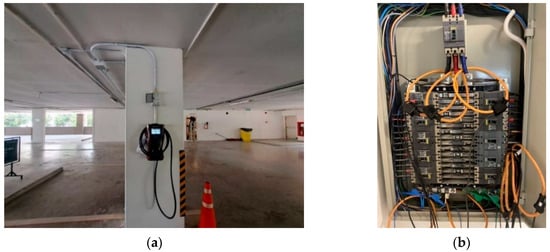
Figure 1.
Installation of an EV charging system in a residential building: (a) location of the EV charging station and (b) connection point and measurement interface with the building’s electrical grid.
- Input voltage: 230 Vac (±10%) for a single phase and 400 Vac (±10%) for three phases;
- Input frequency: 50 Hz / 60 Hz;
- Rated power: 7.4 kW for a single phase and 22 kW for three phases;
- Max output current: 32 A;
- Output connector: Type 2 IEC 62196 Standard;
- Safety features: overvoltage/undervoltage protection, overload protection, leakage protection, overcurrent protection, and ground protection.
The installation area was a designated parking space within a residential condominium, specifically allocated for EV charging services. This separation from general parking ensured that the measured usage reflected actual demand without interference from other vehicles or overlapping usage patterns. The study was conducted on a single EV charger permanently installed at this location. The charger was connected to a low-voltage distribution system with a nominal voltage of 230/400 V at 50 Hz and protected by a 40 A circuit breaker, which reflects a typical setup for residential charging infrastructure.
To measure the electrical parameters of the charger, a measuring device was used to record various related parameters, including the voltage in all three phases, current in each phase, current in the neutral cable, total power, electrical power in each phase, and harmonic values. These data are crucial for analyzing the impact that electric vehicle charging has on the electrical system, as well as for collecting usage data to study the demand of service users in this condominium. Specifically, a professional-grade power quality analyzer, HT Italia PQA823, was used for the measurements. This device is used with an EN50160 and is capable of recording TRMS voltage and current, active/reactive/apparent power, power factor, energy consumption, harmonic distortion up to the 64th order, voltage anomalies, and flicker. The instrument offers a voltage measurement accuracy of ±(0.5% rdg + 2 digits) and a current accuracy of ±(0.5% rdg + 0.06% FS), depending on the current probe used. Data were logged at 1 min intervals throughout the 2-week monitoring period. These capabilities ensured accurate and reliable monitoring of power quality parameters during EV charger operation.
To consider the relationship between usage and the measured parameters, energy demand is illustrated in Figure 2, with blue shades used to indicate the energy use each hour. Dark blue signifies high charger usage, while lighter shades indicate low usage. This visual representation helps to understand the charging behavior of service users.
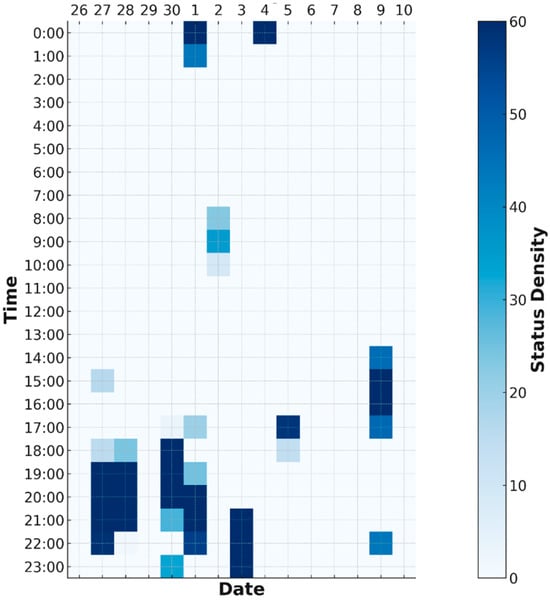
Figure 2.
Time density distribution of EV charger users.
From the table, trends in the use of electric vehicle charging emerge. Usage behavior typically occurs during the evening, from 18:00 to 22:00. During weekends, there are also opportunities for people to use the service at other times, indicating that user behavior aligns with working hours, with increased usage during after-work hours and weekends.
When considering energy use data in the form of graphs, as shown in Figure 3, it is easier to see the duration of use and analyze various electrical parameters.

Figure 3.
Hourly comparison of EV charger usage throughout the day.
3. Load Profile Analysis of EV Chargers
Condominium-type residential buildings have similar energy consumption behavior to other residences but exhibit more variety in energy use due to the different behaviors of the residents. Most electrical systems in these buildings are designed using demand factors, which are estimates of energy use, to appropriately size the equipment without exceeding real needs. However, this demand factor does not yet reflect the additional energy consumption from charging electric vehicles (EVs). Therefore, it is important to study the electrical parameters generated by EV chargers to understand their behavior and the potential impacts on the building’s electrical system.
3.1. Voltage and Current Analysis
Current and voltage are basic parameters used to analyze the behavior of various electrical loads, enabling more efficient system planning and design. Identifying problems such as current overload can prevent damage to connected devices, and voltage monitoring can prevent abnormal operations, allowing the original system to be expanded to support the use of chargers.
Figure 4 shows a voltage profile graph comparing the average voltage reading (Vavg) with the graph state at each time point for the three phases (V1, V2, and V3). An analysis of the average voltage readings (V1,avg, V2,avg, and V3,avg) collected from EV chargers in condominiums is presented. The blue background represents the time periods when there are active electric vehicle charging users. This graph provides insights into the load profile and potential problems within the power system. The graph shows the change in the average voltage over time for the three phases, indicating how the electrical load varies throughout the data collection period.
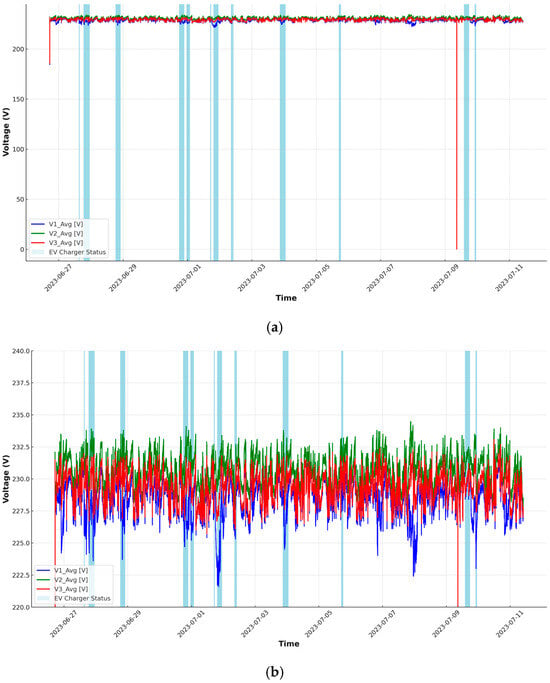
Figure 4.
Voltage profiles of all three phases in relation to EV charger usage: (a) full-range view and (b) zoomed-in view (220–240 V).
The voltage values of all three phases generally show a consistent pattern. However, some anomalies can be observed, including periods when the voltage drops significantly, sometimes reaching zero volts, especially in V1 and V2. There are also cases where the voltage value rises above the normal range. Such fluctuations indicate that the electrical load may be imbalanced or that there may be issues with the charger.
Figure 5 illustrates the maximum current of each phase (I1,Max, I2,Max, and I3,Max) compared with the charging state at each time point. It was found that, during charging periods, the maximum current of each phase is significantly higher, especially in 1-Phase (I1,Max), indicating higher energy usage to charge EVs. During non-charging periods, the peak current of each phase is greatly reduced, indicating lower power consumption. The analysis also revealed that the increase in current during the charging time is directly related to the number and timing of EVs being charged, as shown in the graph depicting the increase in current during continuous charging.
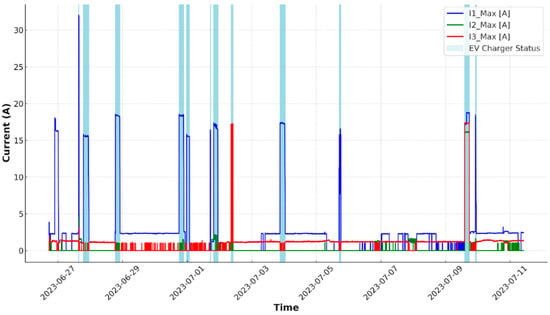
Figure 5.
Maximum current values in each phase during charging and non-charging periods.
This graph shows that there is a higher demand for single-phase charging services than for three-phase charging services. As a result, the current in 1-Phase is higher than in the other phases. It can be observed that significantly higher currents in Phases 2 and 3 occur at certain times, coinciding with specific charging behaviors. This indicates an imbalanced load distribution between the different phases, which may impact power quality, such as causing harmonic and voltage distortion.
During non-charging periods, the maximum current of all phases is very low, indicating minimal or no power consumption during those times. This is consistent with predictions that, when EVs are not being charged, electrical energy use returns to normal levels without affecting the electrical system. This analysis also shows that, during non-charging periods, the electrical system can return to a stable state without stressing the electrical equipment, helping to reduce the risk of electrical problems and maintenance requirements.
From the analyzed data, it was found that, during EV charging periods, the peak current of each phase increases significantly, causing stress on electrical equipment such as transformers, wires, and voltage regulators. This stress may lead to damage or reduce the lifespan of these devices. An imbalanced load distribution between different phases can cause voltage distortion, affecting power quality and the operation of connected electrical equipment. Additionally, electrical wires and equipment in phases with a high current may heat up more than normal, potentially leading to fire or other damage.
3.2. Power Analysis
Another issue analyzed is power consumption. As the electrical system is originally designed for residential use, it may not account for the increased power demands of EV charging. Understanding the behavior of electric power consumption helps in the evaluation of the suitability of installing EV charging equipment without exceeding the electrical system’s capacity and affecting the overall system. Additionally, it allows for an analysis of the equipment’s effectiveness, facilitating further economic analysis for service providers.
A graph of the total power is shown in Figure 6. In the graph, which shows the average power (Pt,avg) in kilowatts (kW) versus the charging status of the EV charger, a notable difference in energy consumption during charging and non-charging periods is evident. During charging times, the electric power increases significantly, consistent with the power requirements of EV chargers. An instantaneous increase in power can be observed from the peaks in the graph, where Pt,avg values reach approximately 12 kW, indicating very high power consumption during these periods.
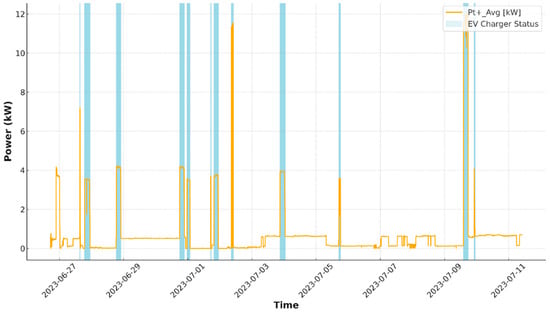
Figure 6.
Total active power measured over time in relation to EV charger usage.
However, the electrical power in each range does not remain constant due to the various types of users utilizing the EV charging services. This variability results in different maximum power levels at different times. Additionally, power consumption occurs even outside the charging periods to operate the charger itself, impacting the electrical system, albeit to a lesser extent.
A deeper analysis considering the power in each phase, as shown in Figure 7, reveals the average power in each phase (P1,avg, P2,avg, and P3,avg) compared to the charging status at each time. During charging periods, the power usage in each phase, especially 1-Phase, increases significantly, indicating higher power usage to charge EVs. Conversely, during non-charging periods, the power consumption in each phase is greatly reduced.
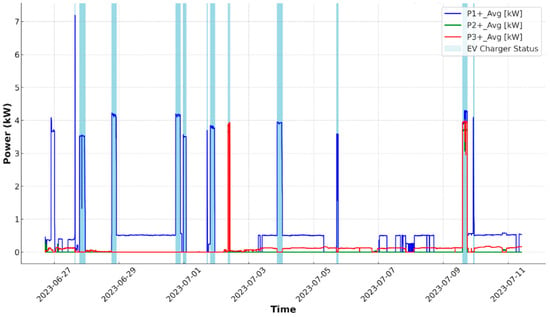
Figure 7.
Average power in each phase during charging operation.
According to the charger’s specifications, it has a rated power of 7.4 kW for single-phase charging and 22 kW for three-phase charging, with a maximum output current of 32 A in both configurations. From the measurement results, it was observed that the charger typically operated below its maximum rated power. Single-phase charging, which constituted most of the charging events, mostly showed that the measured power ranged between 3.5 and 4.3 kW, reaching a maximum recorded power of 7.2 kW, closely aligning with the charger’s rated single-phase power of approximately 7.4 kW. Similarly, three-phase charging consistently remained below the 22 kW specification. These findings are consistent with the compatibility between the charger and the electric vehicles utilized during the test, as many EV models limit the charging power according to their built-in charging capabilities. To ensure the accuracy and validity of these measurement data, repeated tests and the cross-checking of results from two independent measurement points were performed, both of which yielded consistent and reliable readings.
The profile data collected illustrate varying energy consumption behaviors depending on the behavior and type of service users. This diversity directly impacts the connected electrical system, necessitating infrastructure design that accommodates these possible behaviors. The next section presents a study of the direct impacts on the electrical system in order to provide information for designing an appropriate system.
4. Impact on the Electrical System
From the load profile studied, it is evident that the system has a direct impact on the electrical infrastructure due to the unevenness of the load and the varying characteristics of the service users. This results in different power consumption patterns for both single- and three-phase charging, which can lead to various problems requiring detailed analysis and careful consideration.
4.1. Impact of Phase Imbalance Induced by EV Charging
The first observed effect concerns the imbalanced phase conditions arising from the operation of EV chargers. These chargers are capable of functioning in both single- and three-phase modes. However, the single-phase charging most associated with Phase-1 tends to dominate due to user convenience and constraints inherent in the existing electrical infrastructure. This leads to asymmetric loading among the phases, resulting in an elevated current in the neutral conductor. While no direct temperature measurements were performed in this study, such imbalanced loading is theoretically known to increase the risk of conductor heating, which could lead to insulation degradation or fire hazards if not properly managed. Furthermore, current imbalance can lead to voltage fluctuations, thereby impairing power quality and potentially disrupting the operation of sensitive equipment.
In addition to current imbalance, voltage unbalance was analyzed to quantify the degree of asymmetry in the phase voltage during charger operation. The unbalance percentage was calculated based on the maximum deviation of each phase voltage from the average, relative to the average value. This method is suitable for datasets that contain average voltage values without phasor information. As shown in Figure 8, periods of EV charging usually coincide with noticeable increases in voltage unbalance. While the average unbalance across the monitoring period was 0.535%, the peak value reached 2.18% during active charging. These values, though generally within acceptable limits, demonstrate the dynamic impact of EV charger loads on system symmetry.
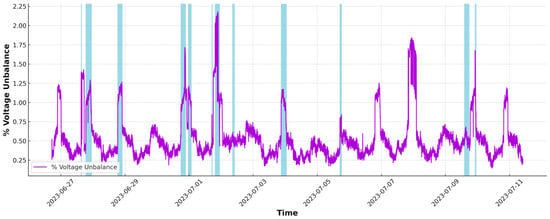
Figure 8.
Comparison of voltage unbalance with and without EV charging activity.
The data obtained from the experiment, as shown in Figure 9, indicate the maximum current of each phase (In,max) relative to the charging state at each time. It was found that, during charging periods, the current in the neutral wire was significantly higher, especially during single-phase charging. For three-phase charging, the neutral current also increased, but to a lesser extent. Additionally, there were periods with current in the neutral wire even outside the recorded usage times, potentially caused by device malfunction or charger installation issues. It is necessary to consider the impact during non-charging periods, as the current generated can be as high as that generated during charging.
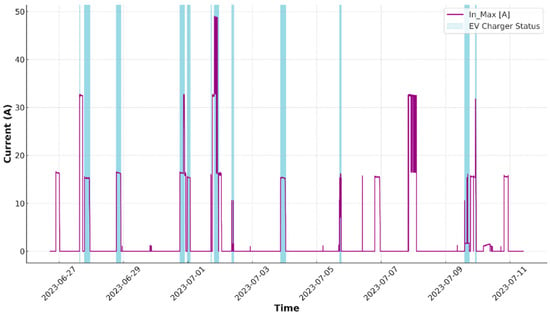
Figure 9.
Neutral current variation corresponding to EV charging activity.
The root causes of phase imbalance observed in this study are attributed to user-driven charging behaviors, unrestricted phase selection, and limitations associated with retrofitted electrical systems in existing condominium developments. In such contexts, the absence of coordinated load balancing or phase allocation control inevitably results in disproportionate phase utilization.
Voltage unbalance can adversely affect the performance and lifespan of electrical equipment. Induction motors operating under unbalanced voltage may experience increased copper losses, reduced torque, excessive vibration, and shortened service life. A voltage unbalance as small as 2% can result in temperature rises, significantly accelerating insulation degradation. In addition, power electronic devices, such as converters and adjustable-speed drives (ASDs), are particularly sensitive to unbalanced conditions. These devices may suffer from current distortion, component overheating, and the premature triggering of protective elements.
In new construction projects where EV charger deployment is anticipated, it is recommended that the electrical system design incorporates infrastructure provisions that facilitate a balanced load distribution, such as dedicated three-phase supplies or phase rotation scheduling algorithms. For existing buildings, a pre-installation load assessment should be conducted to evaluate phase imbalance, and chargers with configurable phase allocation should be utilized where available. If the device allows, phase rotation settings may be periodically adjusted to minimize long-term imbalance.
To mitigate these impacts, a comprehensive management strategy should be adopted, comprising phase load monitoring, periodic electrical audits, proper neutral conductor sizing, and, where feasible, the implementation of phase-aware smart charging systems. Such measures will improve system reliability, reduce maintenance needs, and support the safe integration of EV charging infrastructure in residential buildings.
4.2. Harmonic Distortion Impact
Harmonic effects in the system constitute another factor significantly impacting the electrical infrastructure where residents live. Distortions in current and voltage can reduce power quality, and the resulting harmonics can create distortions in the electrical waveform. This deviation from a pure sine wave can affect the quality of electricity and the operation of electrical equipment connected to the system. Sensitive devices, such as computers and appliances requiring high-quality electricity, may be damaged or malfunction due to current distortion.
Traditional harmonic analysis focuses solely on the amplitude of individual harmonic orders; thus, this study adopts a time-domain perspective by examining real-time variations in the total harmonic distortion (THD) for both voltage and current throughout the EV charging periods. This approach provides greater insights into the operational impact of EV chargers under real-world conditions.
Figure 10 presents the voltage THD across three phases (V1, V2, and V3). The plotted data show that voltage distortion generally remains below 2.5%, with observable cyclical patterns likely corresponding to daily load variations. During charging intervals, indicated by the shaded bands, slight but consistent increases in voltage THD can be observed, particularly in phases V1 and V2. Although the magnitude of distortion remains within acceptable limits, the repetitive elevation during EV charging suggests that harmonic voltage contributions from the charger are measurable and could accumulate under high-penetration scenarios.
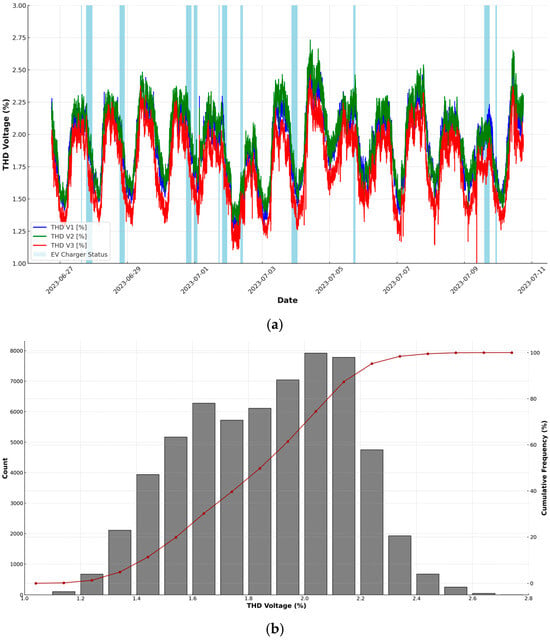
Figure 10.
Voltage harmonic distortion observed during EV charger operation: (a) time series of voltage THD and (b) distribution and cumulative frequency of voltage THD.
Figure 11 shows the current THD in phases I1, I2, and I3 during the same period. The analysis reveals more pronounced effects: THD values increase sharply during active charging sessions, in some cases exceeding 15–20%. The variation across phases reflects the charging configuration, with single-phase charging typically concentrating on one phase. Phase I2 exhibits the highest variability and peak THD, likely due to an unbalanced load distribution and nonlinear current draw.
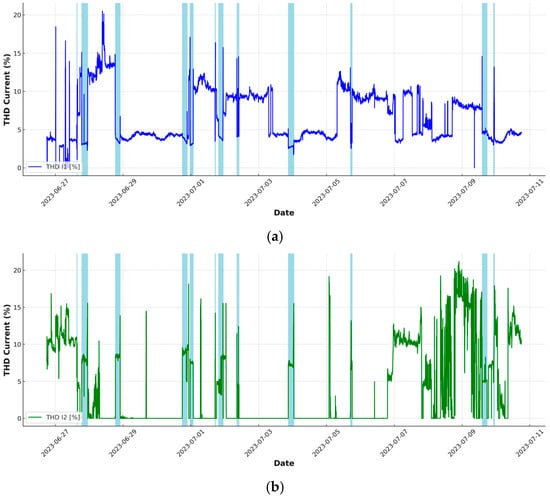
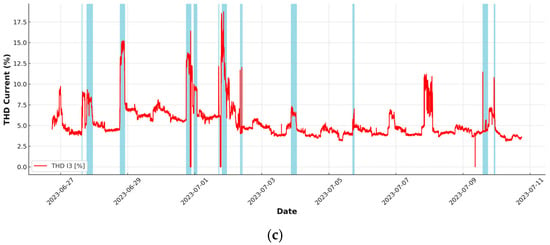
Figure 11.
Current harmonic distortion observed in each phase during EV charger operation: (a) Phase A, (b) Phase B, and (c) Phase C.
These findings confirm that EV charging contributes significantly to current harmonic distortion, while voltage distortion remains comparatively moderate. The imbalance between phases also amplifies the distortion in the neutral conductor, further compounding the issue. The presence of harmonic distortion in electrical systems, particularly under EV charging conditions, can result in multiple adverse effects that compromise both performance and reliability. One of the primary concerns is harmonic resonance, which can amplify certain frequency components in the system and lead to overvoltage conditions or damage to connected equipment. Additionally, increased harmonic currents contribute to thermal stress in electrical components such as transformers, conductors, and especially neutral lines, accelerating insulation aging and reducing the overall system lifespan. Measurement errors may also occur, particularly in metering and protection systems, as harmonics can interfere with the accuracy of instruments that assume sinusoidal waveforms. Furthermore, harmonics may cause electromagnetic interference (EMI) with nearby communication systems and sensitive electronic devices, leading to operational instability. These cumulative effects, if left unmanaged, can degrade the performance of residential power systems over time, even in environments without highly sensitive loads. Therefore, proactive measures should be considered to assess and mitigate harmonic distortion, particularly in buildings undergoing EV charger integration.
To mitigate these effects, a range of strategies can be considered, such as active or passive harmonic filters, load balancing techniques, and the use of harmonic-tolerant devices. In buildings where retrofitting EV chargers are underway, it is recommended to conduct harmonic analyses as part of the electrical audit, especially if the system lacks diversity in load distribution or operates near its design limits.
5. Conclusions
In this research, the impact of EV charging on the electrical system in a condominium was analyzed, utilizing data to store load profiles, currents, and voltages, including harmonic analysis. The findings indicate that the current drawn by the EV charger varies depending on whether the operation occurs in a single- or three-phase mode, an aspect that is not predetermined or easily controlled in typical user environments. As a result, the unpredictable nature of phase utilization leads to fluctuating current levels, particularly in single-phase operation, which can significantly affect power quality and system balance.
EV charging led to varying power consumption patterns for both single- and three-phase charging. In the observed case, most charging activity occurred using single-phase operation, which resulted in higher current levels in the corresponding phase. The power consumption during charging times was significantly higher, with the power (Pt) reaching approximately 12 kW during peak times. Imbalanced phase conditions caused by single-phase charging led to significant current flow in the neutral wire, resulting in potential heat buildup and the risk of damage or fire. Voltage distortions, particularly in the single phase, were observed, indicating an imbalanced load distribution and potential power quality issues.
The harmonic analysis revealed voltage and current distortions at certain times, with maximum distortions observed in the fourth harmonic for 1-Phase and 2-Phase. These distortions can impact the quality of electricity, affecting the operation of sensitive electrical equipment and causing unstable system performance. Harmonic distortions can also lead to resonance, causing further distortion and potential damage to electrical equipment.
In conclusion, this research highlights the importance of good energy management and continuous system monitoring to ensure the efficient and safe use of EVs in residential buildings. Addressing the identified impacts through improved load distribution, regular maintenance, and system upgrades can significantly enhance the power quality and overall stability of the electrical system in condominiums.
In future research, the scope of measurement will be extended to include a broader range of building types and environments. Variations in user behavior, existing electrical infrastructure, and environmental conditions may lead to different impacts on the integration of EV chargers. By capturing this diversity, the analysis will provide a more comprehensive understanding of system performance under real-world conditions. Furthermore, future studies will aim to identify effective mitigation strategies tailored to specific building characteristics, thereby supporting the development of adaptable and resilient EV charging infrastructure.
Author Contributions
Conceptualization and funding acquisition, P.C.; formal analysis and performing the experiments, O.C.; visualization, data analysis, and writing of the original paper, C.S.; experiment design and reviewing and editing, A.N.; resource and project administration, S.A. All authors have read and agreed to the published version of the manuscript.
Funding
This research was funded by the Srinakharinwirot University Research Fund.
Institutional Review Board Statement
Not applicable.
Informed Consent Statement
Not applicable.
Data Availability Statement
Data are contained within the article.
Acknowledgments
The authors wish to gratefully acknowledge the financial support provided by the Srinakharinwirot University Research Fund for this research.
Conflicts of Interest
The authors declare no conflicts of interest.
References
- Farajnezhad, M.; Seong Kuan, J.S.T.; Kamyab, H. Impact of Economic, Social, and Environmental Factors on Electric Vehicle Adoption: A Review. Rev. Eidos 2024, 17, 39–62. [Google Scholar] [CrossRef]
- Albatayneh, A.; Assaf, M.N.; Alterman, D.; Jaradat, M. Comparison of the Overall Energy Efficiency for Internal Combustion Engine Vehicles and Electric Vehicles. Environ. Clim. Technol. 2020, 24, 669–680. [Google Scholar] [CrossRef]
- Li, Y.; Jenn, A. Impact of Electric Vehicle Charging Demand on Power Distribution Grid Congestion. Proc. Natl. Acad. Sci. USA 2024, 121, e2317599121. [Google Scholar] [CrossRef] [PubMed]
- Rashid, M.; Elfouly, T.; Chen, N. A Comprehensive Survey of Electric Vehicle Charging Demand Forecasting Techniques. IEEE Open J. Veh. Technol. 2024, 5, 1348–1373. [Google Scholar] [CrossRef]
- Saraswathi, V.N.; Ramachandran, V.P. A Comprehensive Review on Charger Technologies, Types, and Charging Stations Models for Electric Vehicles. Heliyon 2024, 10, e38945. [Google Scholar] [CrossRef]
- Anjos, M.F.; Gendron, B.; Joyce-Moniz, M. Increasing Electric Vehicle Adoption through the Optimal Deployment of Fast-Charging Stations for Local and Long-Distance Travel. Eur. J. Oper. Res. 2020, 285, 263–278. [Google Scholar] [CrossRef]
- Ermagun, A.; Tian, J. Charging into Inequality: A National Study of Social, Economic, and Environment Correlates of Electric Vehicle Charging Stations. Energy Res. Soc. Sci. 2024, 115, 103622. [Google Scholar] [CrossRef]
- Narasipuram, R.P.; Mopidevi, S. A Technological Overview & Design Considerations for Developing Electric Vehicle Charging Stations. J. Energy Storage 2021, 43, 103225. [Google Scholar] [CrossRef]
- Rathnayake, R.M.D.I.M.; Jayawickrama, T.S.; Melagoda, D.G. Prospect of Establishing Electric Vehicle Charging Stations at Public Hotspots. Intell. Build. Int. 2020, 12, 318–330. [Google Scholar] [CrossRef]
- Su, L.; Kockelman, K.M. Shared EV Charging Stations for the Austin Area: Opportunities for Public-Private Partnerships. Transp. Plan. Technol. 2024, 47, 1314–1330. [Google Scholar] [CrossRef]
- Andrenacci, N.; Valentini, M.P. A Literature Review on the Charging Behaviour of Private Electric Vehicles. Appl. Sci. (Basel) 2023, 13, 12877. [Google Scholar] [CrossRef]
- Shams Ashkezari, L.; Succetti, M.; Jabœuf, R.; Tosco, P.; Brenna, M. Are Commercial EV Chargers Ready to Aid with Household Power Consumption? Electronics 2023, 12, 2065. [Google Scholar] [CrossRef]
- Nutkani, I.; Toole, H.; Fernando, N.; Andrew, L.P.C. Impact of EV Charging on Electrical Distribution Network and Mitigating Solutions—A Review. IET Smart Grid 2024, 7, 485–502. [Google Scholar] [CrossRef]
- Carvalhosa, S.; Ferreira, J.R.; Araújo, R.E. Electric Vehicle Charging Method for Existing Residential Condominiums. IEEE Access 2024, 12, 166537–166552. [Google Scholar] [CrossRef]
- Khalid, M.; Thakur, J.; Mothilal Bhagavathy, S.; Topel, M. Impact of Public and Residential Smart EV Charging on Distribution Power Grid Equipped with Storage. Sustain. Cities Soc. 2024, 104, 105272. [Google Scholar] [CrossRef]
- Minuto, F.D.; Lazzeroni, P.; Borchiellini, R.; Olivero, S.; Bottaccioli, L.; Lanzini, A. Modeling Technology Retrofit Scenarios for the Conversion of Condominium into an Energy Community: An Italian Case Study. J. Clean. Prod. 2021, 282, 124536. [Google Scholar] [CrossRef]
- Cordova-Cruzatty, A.C.; King, D.A.; Kuby, M.; Parker, N. Experiences and Perceptions of Multi-Family Housing Property Managers about Electric Vehicle Charging Provision. Transp. Res. Interdiscip. Perspect. 2024, 28, 101263. [Google Scholar] [CrossRef]
- Buranaaudsawakul, T.; Wisaeng, K. Oversized Electrical Appliance Impacts on Condominium Energy Efficiency and Cost-Effectiveness Management: Experts’ Perspectives. Appl. Syst. Innov. 2021, 4, 98. [Google Scholar] [CrossRef]
- Lopez-Behar, D.; Tran, M.; Froese, T.; Mayaud, J.R.; Herrera, O.E.; Merida, W. Charging Infrastructure for Electric Vehicles in Multi-Unit Residential Buildings: Mapping Feedbacks and Policy Recommendations. Energy Policy 2019, 126, 444–451. [Google Scholar] [CrossRef]
- Avordeh, T.K.; Gyamfi, S.; Opoku, A.A. The Role of Demand Response in Residential Electricity Load Reduction Using Appliance Shifting Techniques. Int. J. Energy Sect. Manag. 2022, 16, 605–635. [Google Scholar] [CrossRef]
- Cieslik, W.; Szwajca, F.; Rosolski, S.; Rutkowski, M.; Pietrzak, K.; Wójtowicz, J. Historical Buildings Potential to Power Urban Electromobility: State-of-the-Art and Future Challenges for Nearly Zero Energy Buildings (nZEB) Microgrids. Energies 2022, 15, 6296. [Google Scholar] [CrossRef]
- Damianakis, N.; Mouli, G.R.C.; Bauer, P.; Yu, Y. Assessing the Grid Impact of Electric Vehicles, Heat Pumps & PV Generation in Dutch LV Distribution Grids. Appl. Energy 2023, 352, 121878. [Google Scholar] [CrossRef]
- Al-Hanahi, B.; Ahmad, I.; Habibi, D.; Masoum, M.A.S. Charging Infrastructure for Commercial Electric Vehicles: Challenges and Future Works. IEEE Access 2021, 9, 121476–121492. [Google Scholar] [CrossRef]
- Wu, W.; Lin, B. Benefits of Electric Vehicles Integrating into Power Grid. Energy 2021, 224, 120108. [Google Scholar] [CrossRef]
- Ravi, S.S.; Aziz, M. Utilization of Electric Vehicles for Vehicle-to-Grid Services: Progress and Perspectives. Energies 2022, 15, 589. [Google Scholar] [CrossRef]
- Singh, B.; Dubey, P.K. Distributed Power Generation Planning for Distribution Networks Using Electric Vehicles: Systematic Attention to Challenges and Opportunities. J. Energy Storage 2022, 48, 104030. [Google Scholar] [CrossRef]
- Patil, P.; Kazemzadeh, K.; Bansal, P. Integration of Charging Behavior into Infrastructure Planning and Management of Electric Vehicles: A Systematic Review and Framework. Sustain. Cities Soc. 2023, 88, 104265. [Google Scholar] [CrossRef]
- Salama, H.S.; Said, S.M.; Aly, M.; Vokony, I.; Hartmann, B. Studying Impacts of Electric Vehicle Functionalities in Wind Energy-Powered Utility Grids with Energy Storage Device. IEEE Access 2021, 9, 45754–45769. [Google Scholar] [CrossRef]
- Rodríguez-Pajarón, P.; Hernández, A.; Milanović, J.V. Probabilistic Assessment of the Impact of Electric Vehicles and Nonlinear Loads on Power Quality in Residential Networks. Int. J. Electr. Power Energy Syst. 2021, 129, 106807. [Google Scholar] [CrossRef]
- Weekx, S.; Van den Bergh, O.; Tal, G.; Vanhaverbeke, L. EV Charging Habits and Their Impact on Public Charging Infrastructure Usage. Transp. Res. D Transp. Environ. 2025, 143, 104730. [Google Scholar] [CrossRef]
- Kampik, M.; Skórkowski, A.; Pecyna, M.; Sowula, K. The Influence of Subsequent Harmonics of the Load Current on Errors of Electronic Energy Meters. Energies 2024, 17, 1003. [Google Scholar] [CrossRef]
- Ahmed, A.; Iqbal, A.; Khan, I.; Al-Wahedi, A.; Mehrjerdi, H.; Rahman, S. Impact of EV Charging Station Penetration on Harmonic Distortion Level in Utility Distribution Network: A Case Study of Qatar. In Proceedings of the 2021 IEEE Texas Power and Energy Conference (TPEC), College Station, TX, USA, 2–5 February 2021. [Google Scholar]
- İnci, M.; Çelik, Ö.; Lashab, A.; Bayındır, K.Ç.; Vasquez, J.C.; Guerrero, J.M. Power System Integration of Electric Vehicles: A Review on Impacts and Contributions to the Smart Grid. Appl. Sci. 2024, 14, 2246. [Google Scholar] [CrossRef]
- Dias Vasconcelos, S.; Filho da Costa Castro, J.; Gouveia, F.; Venancio de Moura Lacerda Filho, A.; Fonseca Buzo, R.; Henrique Alves de Medeiros, L.; Rodrigues Limongi, L.; da Costa Marques, D.; Lopes Fernandes, A.; Chai, J.; et al. Assessment of Electric Vehicles Charging Grid Impact via Predictive Indicator. IEEE Access 2024, 12, 163307–163323. [Google Scholar] [CrossRef]
- Senol, M.; Bayram, I.S.; Hunter, L.; Sevdari, K.; McGarry, C.; Gaona, D.C.; Gehrke, O.; Galloway, S. Harmonics Measurement, Analysis, and Impact Assessment of Electric Vehicle Smart Charging. IEEE Open J. Veh. Technol. 2025, 6, 109–127. [Google Scholar] [CrossRef]
- Srivastava, A.; Manas, M.; Dubey, R.K. Integration of Power Systems with Electric Vehicles: A Comprehensive Review of Impact on Power Quality and Relevant Enhancements. Electr. Power Syst. Res. 2024, 234, 110572. [Google Scholar] [CrossRef]
- Gurav, N.; Pradeepa; Adhokshaja, M.S.; Anoor, P.; Bilgundi, S.K. Mitigation of Electric Vehicles Impact on Grid Current Harmonics Using DERs. Aust. J. Electr. Electron. Eng. 2024, 21, 228–242. [Google Scholar] [CrossRef]
- Srivastava, A.; Saravanan, S. Harmonic Mitigation Using Optimal Active Power Filter for the Improvement of Power Quality for a Electric Vehicle Changing Station. e-Prime-Adv. Electr. Eng. Electron. Energy 2024, 8, 100527. [Google Scholar] [CrossRef]
Disclaimer/Publisher’s Note: The statements, opinions and data contained in all publications are solely those of the individual author(s) and contributor(s) and not of MDPI and/or the editor(s). MDPI and/or the editor(s) disclaim responsibility for any injury to people or property resulting from any ideas, methods, instructions or products referred to in the content. |
© 2025 by the authors. Licensee MDPI, Basel, Switzerland. This article is an open access article distributed under the terms and conditions of the Creative Commons Attribution (CC BY) license (https://creativecommons.org/licenses/by/4.0/).